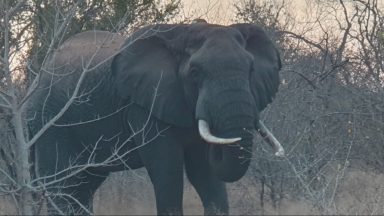Back in 2018, Cape Buffalo were brought into Zambia’s Simalaha Community Conservancy from the Waterberg Mountain Plateau National Park, an area located in Central Namibia which rises out of the arid savannah reaching between 1650 and 1700m above sea level. Due to both the altitude and remoteness of the Waterberg Plateau, these buffalo are one of the few populations in Namibia that have remained disease-free, making them the perfect candidates for a strong and healthy founder population in an area where people directly rely on livestock for their livelihoods.
This is a very important aspect due to the fact that buffalo are often plagued with diseases such as foot-and-mouth, bovine tuberculosis and corridor disease, all of which have the ability to decimate these livestock populations, threatening the livelihoods of local farmers and communities.
Gordon Homer, Peace Parks’ Project Manager for Kavango Zambezi Transfrontier Conservation Area, is delighted to finally get a glimpse of these ill-tempered animals grazing safely inside the Simalaha sanctuary fence next to the main road. Although extremely large, buffalo can remain quite elusive which has been proven to Gordon time and time again. Despite spending countless hours driving inside the buffalo breeding camp and often travelling along this road, this was the first occasion that he had encountered them since their initial release.
With the goal of having a solid founder population of buffalo within the conservancy now achieved, a small number of them will be sold each year to game reserves within Zambia. The sale of one of these animals will directly contribute to making Simalaha financially sustainable.
Although the disease-free status is by far the most important aspect when buying and selling buffalo, another factor that comes into play is favourable genetics, which appeals to potential buyers. These buffalo come from very good stock resulting in a great horn structure and boss, a term for the characteristic growth-like feature situated at the base of the horns.
Apart from playing an important role within the ecosystem and being a totem animal in Senior Chief Inyambo Yeta’s chiefdom, having buffalo in the Simalaha Conservancy is also vital for tourism, with the Big 5 being a major drawcard for many visitors. It is therefore extremely important that these buffalo are well looked after, and this is where Simalaha Project Manager, Ian Middleton, and his team have excelled.
As Ian explains in the video above, these mighty beasts cannot be handled so a nifty invention called the Duncan Applicator has been introduced in the buffalo breeding camp to keep the animals free from disease-carrying ticks and other parasites. Attracted to licking the nutrient-rich mineral blocks placed at the base of the applicator, the motion of the buffalo’s head ensures that its neck rubs up and down the applicator which is covered in a pour-on dip. The substance will eventually make its way from the buffalo’s neck to its tail ensuring that every part of its body is covered.
Ian and his team are also hard at work ensuring that the buffalo have enough food and water to get them through the dry season when resources become limited.
The significance of the reintroduction and further protection of buffalo to Simalaha provides not only economic benefit to the conservancy and its community but serves as an outstanding example of how when community and conservation-based efforts come together, both the natural and cultural heritage of an area can be restored and preserved for future generations.
Keep an eye out on Peace Parks TV for more daily updates.


